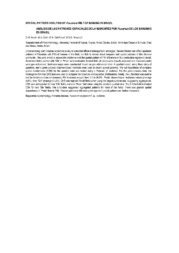Spatial pattern analysis of Fusarium wilt of banana in Brazil.
Spatial pattern analysis of Fusarium wilt of banana in Brazil.
Author(s): HECK, D. W.; RODRIGUEZ, M. A. D.; DEL PONTE, E. M.; MIZUBUTI, E. S. G.
Summary: Understanding plant disease epidemics is key to establish efficient management strategies. Several factors can affect epidemic patterns of Fusarium wilt (FW) of banana in the field, but little is known about temporal and spatial patterns of this disease worldwide. This work aimed to assess the incidence and the spatial pattern of FW of banana in four production regions in Brazil. Seventeen fields planted with ?Silk? or ?Prata? were evaluated. In each field, all plants were visually assessed and diseased plants were geo-referenced. Incidence maps were constructed based on geo-referenced data. A quadrat-based, using three sizes of quadrats, and a point-process distance-based methods were used to detect spatial patterns. The null hypothesis of complete spatial randomness (CSR) for the quadrat data was tested using a Pearson ?2 statistics. For the point-process data, the Kolmogorov-Smirnov (KS) test was used to compare the observed and expected distributions. Finally, the L-function was used to test for deviations from randomness. FW incidence ranged from 2.1 to 38.5%. ?Prata? showed lower incidence values (average 8.9%), than ?Silk? (average 17.2%). CRS was rejected for all fields when using the largest quadrat size, suggesting aggregation. CRS was not rejected for four ?Silk? fields and one ?Prata? field when using the smallest quadrat size. The K-S test did not reject CSR for two ?Silk? fields. The L-function suggested aggregated patterns for most of the fields. There was greater spatial dependence in ?Prata? than in ?Silk?. Factors putatively influencing the reported spatial patterns are further discussed.
Publication year: 2017
Types of publication: Abstract in annals or event proceedings
Unit: Embrapa Environment
Keywords: Banana, Fusarium oxysporum f sp cubense, Panama disease, epidemiology
Observation
Some of Embrapa's publications are published as ePub files. To read them, use or download one of the following free software options to your computer or mobile device. Android: Google Play Books; IOS: iBooks; Windows and Linux: Calibre.
Access other publications
Access the Agricultural Research Database (BDPA) to consult Embrapa's full library collection and records.
Visit Embrapa Bookstore to purchase books and other publications sold by Embrapa.

